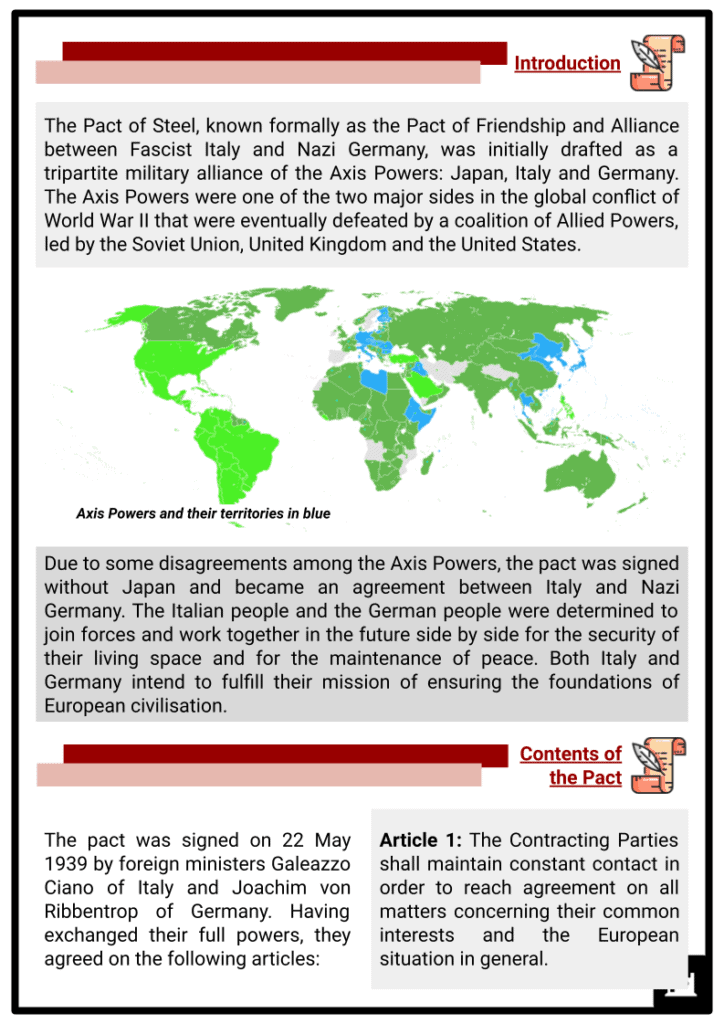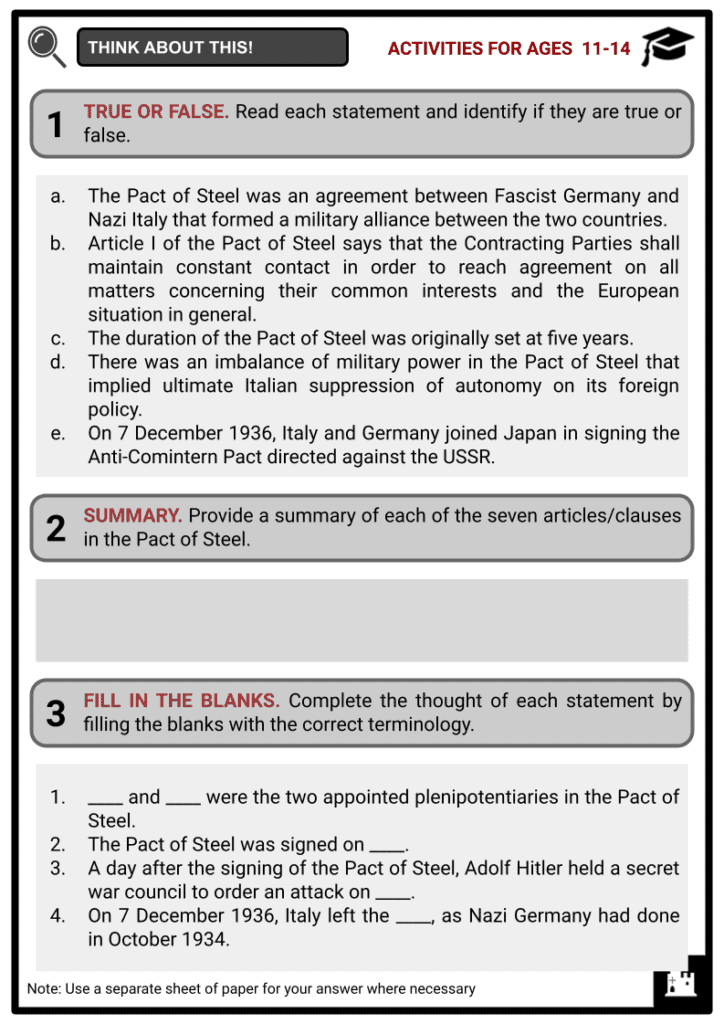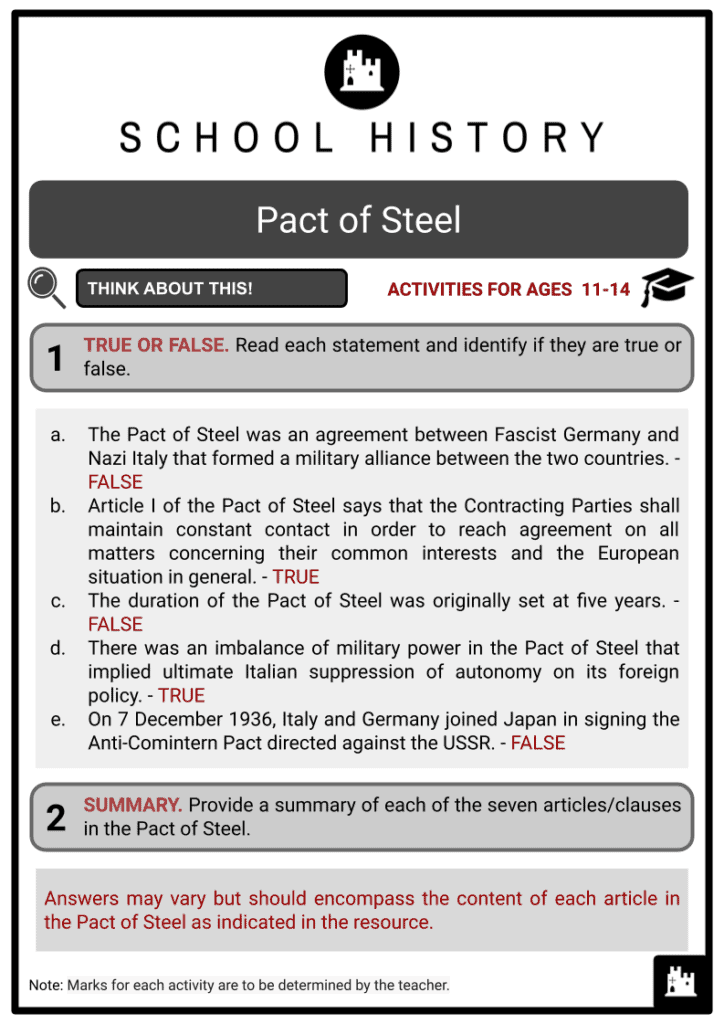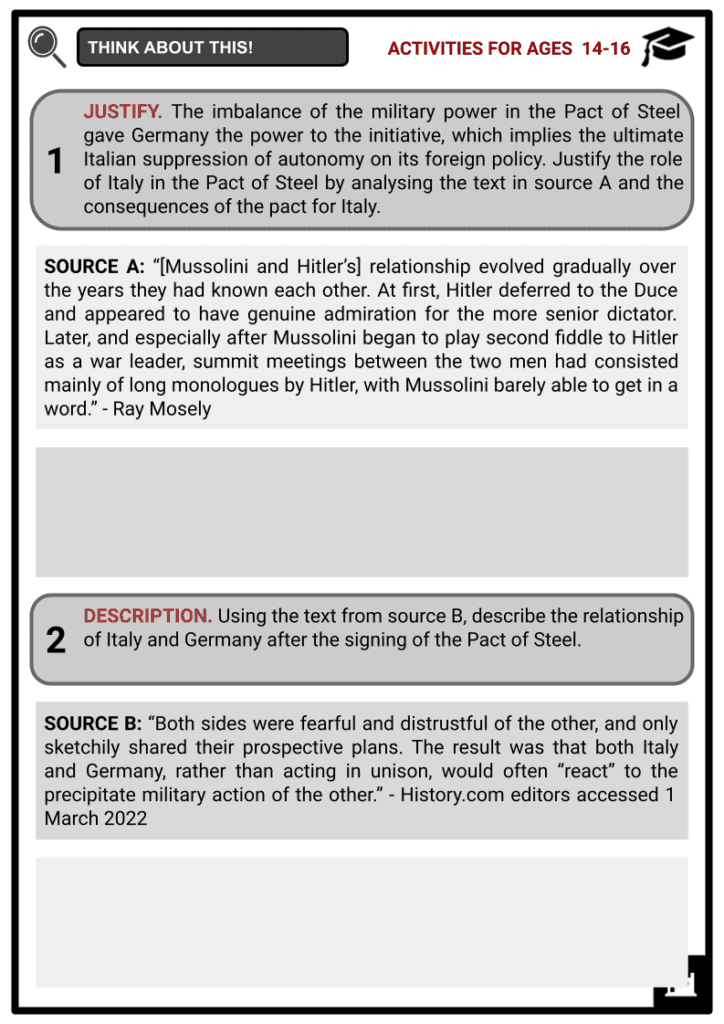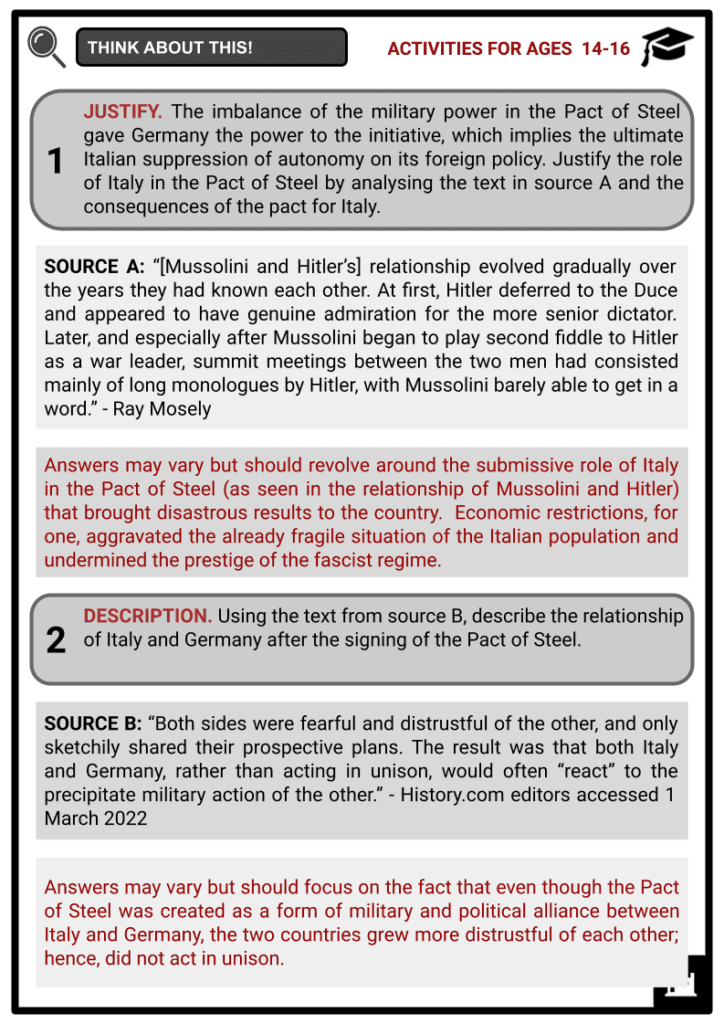Download Pact of Steel Worksheets
Do you want to save dozens of hours in time? Get your evenings and weekends back? Be able to teach about the Pact of Steel to your students?
Our worksheet bundle includes a fact file and printable worksheets and student activities. Perfect for both the classroom and homeschooling!
Summary
- Introduction to the Pact of Steel
- Contents of the pact
- The parts of the agreement
- Consequences of the pact
- Collaboration between Italy and Nazi Germany
- Italy in the Second World War
Key Facts And Information
Let’s know more about the Pact of Steel!
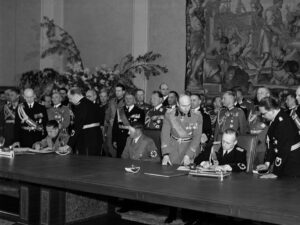
The Pact of Steel was an agreement between Italy and Germany that formed a military alliance between the two countries. It was the birth of the Axis powers. The pact had both defensive and offensive terms requiring the two countries to come to the rescue of each other.
Introduction
- The Pact of Steel, known formally as the Pact of Friendship and Alliance between Fascist Italy and Nazi Germany, was initially drafted as a tripartite military alliance of the Axis Powers: Japan, Italy, and Germany. The Axis Powers were one of the two major sides in the global conflict of World War II that were eventually defeated by a coalition of Allied Powers, led by the Soviet Union, United Kingdom, and the United States.
- Due to some disagreements among the Axis Powers, the pact was signed without Japan and became an agreement between Italy and Nazi Germany. The Italian people and the German people were determined to join forces and work together in the future side by side for the security of their living space and for the maintenance of peace. Both Italy and Germany intend to fulfill their mission of ensuring the foundations of European civilisation.
Contents of the Pact
- The pact was signed on 22 May 1939 by foreign ministers Galeazzo Ciano of Italy and Joachim von Ribbentrop of Germany. Having exchanged their full powers, they agreed on the following articles:
- Article 1: The Contracting Parties shall maintain constant contact in order to reach agreement on all matters concerning their common interests and the European situation in general.
- Article 2: Whenever the common interests of the Contracting Parties run the risk of being threatened by international events of any kind, they shall immediately enter into consultation as to the measures to be taken for the protection of those interests. Should the security or other vital interests of one of the contracting parties be threatened from outside, the other contracting party shall give the threatened party full political and diplomatic support to eliminate that threat.
- Article 3: If, in spite of the desires and hopes of the Contracting Parties, one of them were caught up in an armed conflict with another or with other powers, the other contracting party shall immediately proceed to its side as an ally and support it with all its military forces, on land, on sea, and in the air.
- Article 4: In order to ensure, in the case envisaged, the swift implementation of the alliance commitments assumed under Article 3, the governments of the two Contracting Parties will further deepen their military and economic collaboration of war. In the same way, the two governments will maintain constant contact for the adoption of the other measures necessary for the practical application of the provisions of the present pact. For the purposes indicated in paragraphs 1 and 2 above, the two governments will constitute standing committees, to be placed under the authority of the two foreign ministers.
- Article 5: The Contracting Parties undertake immediately, in the case of a war conducted in common, not to conclude an armistice or peace if there is no full agreement between them.
- Article 6: The two Contracting Parties, aware of the importance of their common relations with the friendly powers, are determined to maintain and develop by mutual agreement in the future these relations in harmony with the convergent interests that bind them to these powers.
- Article 7: This pact comes into force immediately after its signature. The two Contracting Parties agree to fix the first period of validity at ten years. They shall agree in good time, before the expiry of this period, on the extension of the validity of the pact. In faith thereof, the Plenipotentiaries have signed the present Covenant and have thereto affixed their seals. Done in two originals, in the Italian and German languages, both texts being equally authentic.
The Parts of the Agreement
- The pact was divided into two parts:
- The first part was an open declaration of continued mutual trust and cooperation.
- The second part was a ‘secret supplementary protocol’ that encouraged a union of economic and military policies. This was further divided into two subsections:
- Hasty joint action on economic and military cooperation
- Promote power and image of fascism through media propaganda
- The pact held a ‘defensive’ and ‘offensive’ alliance between the two countries, specifically: the parties were required to provide mutual political and diplomatic assistance in an international situation that could endanger their “vital interests”. This aid would be extended to the army if it unleashed a war.
- The two countries were also committed to consulting permanently on international issues and, in case of war, not to sign separate peace treaties. The duration of the treaty was originally set at ten years.
Consequences
- The fact that the agreement was both defensive and offensive was an important innovation in the history of international relations. The imbalance of the military power of the two countries gave Germany the power to the initiative, which implies the ultimate Italian suppression of autonomy on its foreign policy. Some members of the Italian government, including the signatory Galeazzo Ciano, Minister of Foreign Affairs, opposed the pact, but to no avail.
- Although there was no established date of the beginning of the conflict that seemed inevitable, Benito Mussolini did not fail to repeatedly communicate to Adolf Hitler that Italy would be ready for war for two or three years. On 23 May 1939, however, the day after the signing of the Steel Pact, Hitler held a secret war council to order an attack on Poland. For the Germans, the Italians had the task of containing the reaction of France and England in the Mediterranean.
- Mussolini, however, reportedly refused to follow the war in Germany because of the non-disclosure of the Molotov-Ribbentrop and the failure to consult with Italy before the invasion of Poland. After nine months of forced ‘non-war’, Mussolini led Italy into the war on the German side in June 1940.
Collaboration Between Italy and Nazi Germany
-
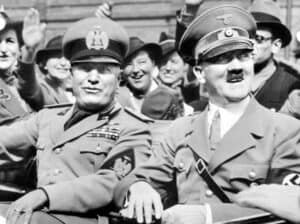
Hitler and Mussolini From 1936, fascist Italy became the ally of Nazi Germany. Mussolini, a pioneer of fascism in Europe and until then the equal of Hitler gradually became the second and was dragged into the dangerous expansionist policy of Nazi Germany.
- In March 1936, Mussolini, just like Hitler, intervened in the Spanish Civil War (1936-1939). Italy sent 70,000 men to support the nationalist rebels commanded by General Franco. In October 1936, Mussolini and Hitler formed the Axis Rome-Berlin and on 6 November, the two countries were joined by Japan to sign the Anti-Comintern Pact directed against the USSR. On 7 December, Italy left the League of Nations as Nazi Germany had done in October 1934.
- Mussolini did not intervene when in 1938, Hitler invaded and annexed Austria (Anschluss). As compensation, he obtained the Austrian High Adige, which forced 70,000 German-speakers to leave the country.
- In September 1938, Mussolini was one of the signatories of the Munich Agreement, which decided to dismember Czechoslovakia for the benefit of Germany. In March 1939, Italy and Germany signed the Steel Pact, which provided for the entry into war of one of the two countries if the other entered into conflict. In April 1939, Italy, in view of a later action against Greece, attacked the kingdom of Albania. The king of Italy Victor-Emmanuel III became the sovereign of Albania at the beginning of May.
Italy in the Second World War
- Aware that the Italian army was not ready to wage a protracted war, Mussolini did not intervene militarily when the Second World War broke out on 3 September 1939. However, the German offensive victory against the Franco-British in May-June 1940 pushed him to declare war. He hoped to participate in the peace treaty and to obtain benefits. Italy would gain the area of occupation of Nice.
- Wanting to emulate German successes in September 1940, Italy attacked English Egypt from Italian Libya. It was a disastrous failure and in February 1941, it had to appeal for German military aid. At the end of October 1940, Italy attacked Greece, but the country’s resistance forced it to stop its troops.
- In April 1941, Italy attacked Yugoslavia, but here too the Yugoslav resistance forced the Germans to intervene, to occupy the country, and to wage war against the resistance fighters. To compensate for German troops immobilised in Yugoslavia and to participate in the anti-Communist ‘crusade’, Mussolini sent an expeditionary force to the USSR to help the Germans when they attacked the USSR in June 1941.
- Italy’s entry into the war was disastrous for the country. Economic restrictions aggravated the already fragile situation of the population and undermined the prestige of the fascist regime. In May 1943, in North Africa, the Italians and their German allies of Afrika-Korps were defeated by the Anglo-French-American Allies.
Image Sources
- https://upload.wikimedia.org/wikipedia/commons/0/03/Patto-acciaio.jpg
- https://th-thumbnailer.cdn-si-edu.com/mhjKcbF_X0oBIHeV1rPrrAkggV4=/fit-in/1600x0/https://tf-cmsv2-smithsonianmag-media.s3.amazonaws.com/filer/12/31/1231652b-8531-4350-9d5f-98093eb8edbe/bundesarchiv_bild_146-1969-065-24_munchener_abkommen_ankunft_mussolini-wr.jpg


